![]() IDEAS
IDEAS
![]() Tweet
Tweet
 Vacation
Rentals
Vacation
Rentals
![]()
|
Made With |
|
|
|
|
Dr. Hoffer's Travel WebSite This site was last updated 05/01/13 |
Saturday, July 16, 2011
[Well, it has taken eight months to add a new page to all the other Trips and now I am back to the most recent one.]
Time for some
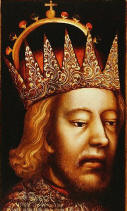 history of Novo Mesto. It is called the
"metropolis of
Dolenjska," and was founded in the year 1365, when the Austrian Archduke
Rudolf IV
(1339�1365)
(left) granted city rights to the town at the bend of
the
Krka River.
Officially called Rudolsfwerd, it grew as Novo Mesto and soon became an
administrative, cultural,
history of Novo Mesto. It is called the
"metropolis of
Dolenjska," and was founded in the year 1365, when the Austrian Archduke
Rudolf IV
(1339�1365)
(left) granted city rights to the town at the bend of
the
Krka River.
Officially called Rudolsfwerd, it grew as Novo Mesto and soon became an
administrative, cultural,
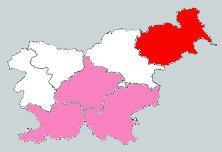 religious and business center of Dolenjska. Novo
Mesto is situated in the midst of the hilly landscape of Dolenjska, embraced by
the Krka River.
religious and business center of Dolenjska. Novo
Mesto is situated in the midst of the hilly landscape of Dolenjska, embraced by
the Krka River.
The Krka Valley, located just above
Novo Mesto is, to some, the most beautiful river valley in Slovenia with
river banks, picturesque rapids and natural dams.
Today we are leaving
(right) the
central southern part of Slovenia (pink) and heading to the most northeastern Province of �tajerska
(red)
[Shtah-yer-skah]
.jpg) to
the spa resort town of Roga�ka Slatina.
to
the spa resort town of Roga�ka Slatina.
I woke at 5:15, 6:45 and again at 10:35. At 12:00, I got up, showered and packed so we could check out of the hotel by 12:30. I complained loudly to the man at the desk (below left) that there was no air conditioning or free parking as was promised. He finally, reluctantly, admitted that the "air conditioning would be repaired quickly" was a lie he was told to say ...
... and all I got was a reluctant free cappuccino (below) which I drank while waiting for Marcia to come down.
She then brought in the receipt we had to pay for our "free" parking. Note the Booking.com reservation stating free parking availavle.
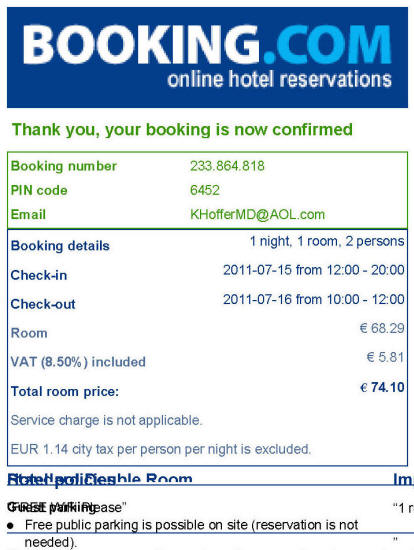
.jpg)
Here is their breakfast area which is pretty quiet at this time of day.
This could be and probably was a very nice hotel. Too bad the management today is so deceitful and has let the place go by not repairing the air conditioning and assuring parking for their guests.
After finishing my cappuccino, at 1:25, I went for my run trying to get to the banks of the Krka River. I went down this hill by a sports complex and found this trail near the soccer field.
As the trail headed along the right side of the field, I saw the river (below right) which is what I wanted. It was really a wonderful scenic run.
As I went along, the hills rose up (below left) on my left side and there were some very nice houses on the cliff above with beautiful views. This one (below right) had access to the river.
As I ran along more I was on a "street" called Pugljeva Ulica with houses on both sides and finally reached the Kandijski Most.
.jpg)
The Kandija Bridge (most) or the Old Bridge (Stari most) (below left) is built of iron. It connects the old city core on the left side of the Krka River with Kandija, the historical suburb of Novo Mesto, on its right side (map.)
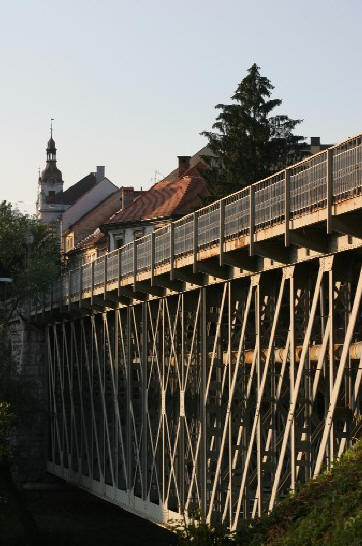
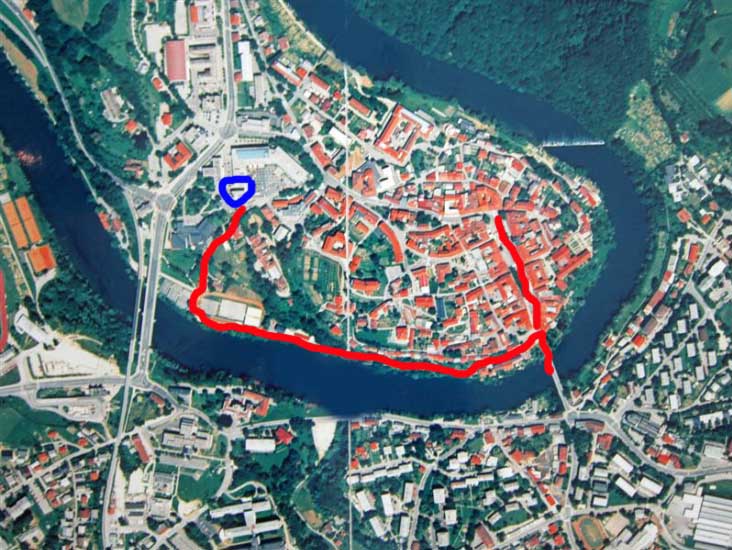
On the map you can see my run from the Krka Hotel (blue) down to the soccer field and to the bridge. The bridge is situated at the lower part of the Main Square and was built in 1898 to replace the old wooden bridge built in 1600, located up the stream. The opening took place in 1898. The riveted structure bridging the Krka with a single 246 ft (75 m) arch is a unique structure in Slovenia and since 1992, it has been protected as a cultural monument. I ran out onto the bridge and got some shots looking upstream ...
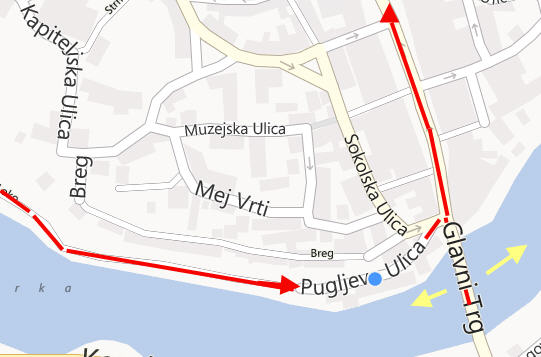
... and then looking downstream.
The street on the bridge is called Glavni trg and becomes the main street of the town.
.jpg)
Here are views up Glavni. I went by this restaurant and I noticed that their advertising was somewhat modern.
.jpg)
.jpg)
As I wondered up Glavni, I came across this pretty little church on Franči�kanski trg.
.jpg)
It is called the Kloster of St. Franči�kanski and in front is a bronze statue of Hugolin Sattner Skladatelj (1851-1932) probably a prior priest from here. Below right is a stock photo of the view from the back.
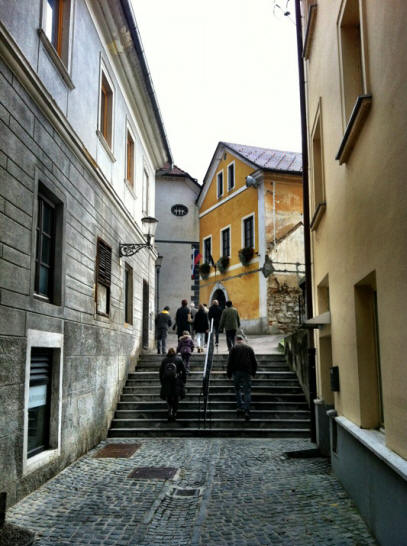
The church was open but it was rather dark inside. The pulpit (right) was beautifully carved wood.
%20e.jpg)
.jpg)
Here is the main alter and apse (below left) and the organ above the door (below right.)
.jpg)
I left there and continued down the street and came across this portico with a huge mirror in the back and took a photo of me in it. I then arrived at their City Hall (below right) which has two bronze statues out front which you can see below on either side of the main entrance.
They are of two famous writers attached to this city. On the left (below) is Dragotin Kette (1876�1899) who was born in Novo Mesto and in his short 23 years became a famous Slovene Impressionist and Neo-Romantic poet. Together with Josip Murn, Ivan Cankar, and Oton �upančič, he is considered the founder of modernism in Slovene literature. In the center is the stone crest of the city.
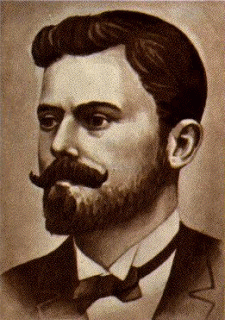
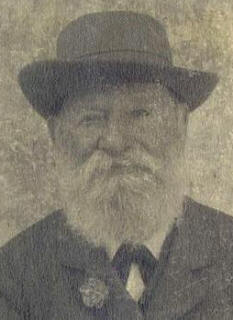
The statue on the right (above) is of Janez Trdina (1830�1905) who was a Slovene writer and historian who moved to Novo Mesto later in life. The renowned author Ivan Cankar described him as the best Slovene stylist of his period.

When I was finished I
walked around through some of the side streets and then at 1:30, I stopped in
this gallery called
Galerija
Simulaker [Vrhovčeva ulica 1a,
![]() +386-3-138-4966]
and met Maid (Maite) who showed me around. I don't believe they get too
many American tourists here, so he was very friendly.
+386-3-138-4966]
and met Maid (Maite) who showed me around. I don't believe they get too
many American tourists here, so he was very friendly.
.jpg)
.jpg)
The most interesting piece was by Miha Erjavec called "Self-Portrait" (2008-9) digital printing mixed media on aluminum.
.jpg)
Each thin aluminum slat has three sides. When all are aligned properly he is covered in hair and beard. As the slats are rotated he becomes bald and clean-shaven. To see it in action, download this small 20 sec video clip (56 MB.)
.jpg)
The next I thought interesting as well was this unusual painting called "Tandem Eclipse, Pax Slovenica" which was rather eerie with this nude sitting on a red skeleton.
.jpg)
I never understood what it was about but on the painting it says "partizanov in artivistov osvobodilne" which means "partisans and activists Liberation," probably about Slovenian independence.
.jpg)
.jpg)
The final one I shot was by Elvis Halilović called "Inverted Fisheye Pinhole 1" which was a ceramic bowl with a negative impression of a motorcycle inside the bowl done using a pinhole projection.
.jpg)
.jpg)
Here are some stock photos of some of their past activities.
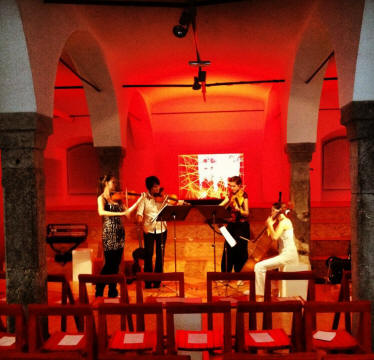

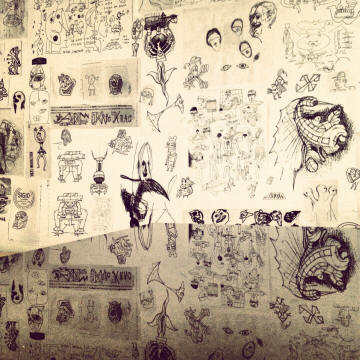
At 2:05, I thanked him and bid my good-byes and then headed down another street called Rozmanova ulica and found this little place called Pekarna (bakery) Arsa [Romanova ulica 4.] Doesn't that look good?
.jpg)
.jpg)
I bought some of this bread and it only cost �0.50. I then headed back to the main street, Glavni (below right.)
At 2:15 I decided to take a rest and have a cappuccino at
Pub Pri
Vodnjaku [Glavni trg 3,
![]() +386-4-161-6882]
which only cost me �1.20. Below left is my photo and their stock photo on
the right.
+386-4-161-6882]
which only cost me �1.20. Below left is my photo and their stock photo on
the right.
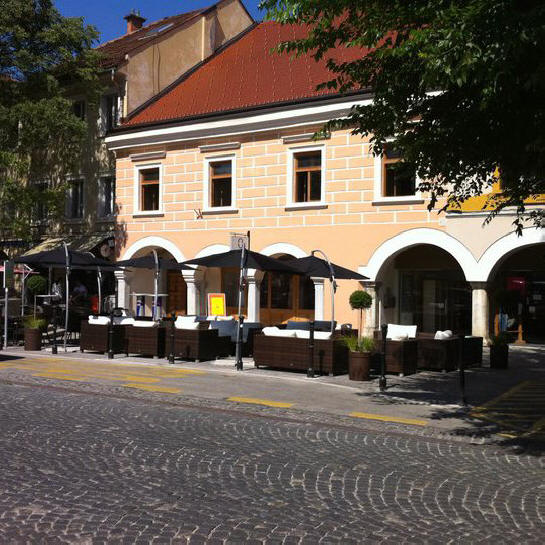
It was a relaxing spot under the umbrellas but I had to get going.
Before I left I went inside to see what it looked like in the bar.
.jpg)
In the men's room I had to laugh at these signs for products in the vending machines.
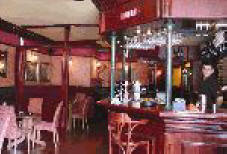
.jpg)
.jpg)
At 2:00 Marcia had her lunch at Zavod (Institute)
Situla [Pre�ernov trg 6] and had
a polenta tuna solata
(salad) and a coke. The word "situla"
is the name for urn-like vases. An
ancient people here buried their dead in these urns and a large number of them have
been unearthed in this area (see below.)
I had texted Marcia when
I left the pub and she let me know where she was. I walked over to join her. At 2:45 I met her there and
we walked to
this special museum they have here. At 3:00 we entered the Muzej (Museum) of Dolenjska,
[Muzejska ulica 7,
![]() +386-7-373-1130]
(Official Site.)
+386-7-373-1130]
(Official Site.)
.jpg)
We had to climb down these stairs to find the entrance. It wasn't very busy and the ladies there were very friendly and happy to see two Americans coming to visit.
.jpg)
The entry fee was �5 each for seniors and she gave us our tickets (below.) The reverse side had an ad for Otoĉec Castle Hotel which is outside the city and very famous.
.jpg)
.jpg)
We started in the entry with this topographic map of Slovenia and a photo of the storks in their nest. On the map you can see in red the Julian Alps in the upper left corner.
.jpg)
.jpg)
Then we went into area of the prehistoric era. You can read the introduction below.
.jpg)
.jpg)
There were many fossils on display.
.jpg)
.jpg)
Then they had displays of objects from the Stone Age, the pottery age, the Iron Age and the Bronze Age.
.jpg)
.jpg)
.jpg)
.jpg)
.jpg)
.jpg)
They described all the objects in English.
.jpg)
.jpg)
.jpg)
.jpg)
The display of the Urnfield Culture (13th-8th Century BC) showed the cremation burial bowls or urns which are called situlas. They distinguished between male and female situlas.
.jpg)
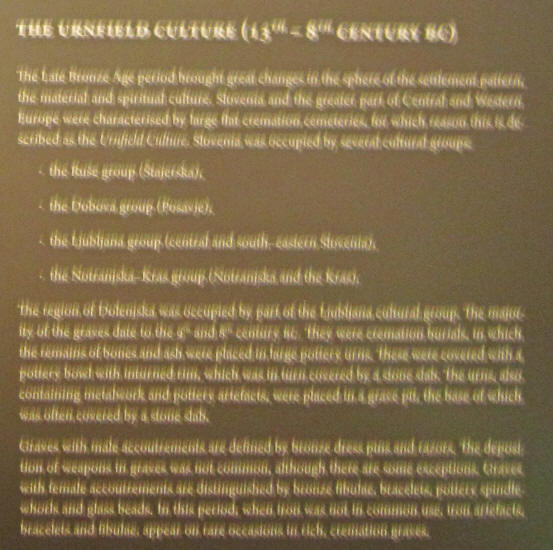
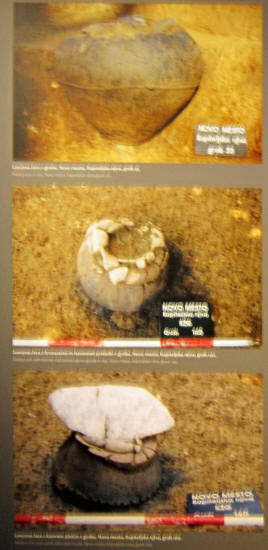
.jpg)
.jpg)
.jpg)
.jpg)
.jpg)
.jpg)
.jpg)
.jpg)
.jpg)
.jpg)
.jpg)
.jpg)
.jpg)
There were photos of nearby excavations of burial sites (below left) and one with a skeleton in it.
.jpg)
.jpg)
.jpg)
.jpg)
.jpg)
.jpg)
.jpg)
.jpg)
.jpg)
.jpg)
.jpg)
.jpg)
.jpg)
.jpg)
.jpg)
.jpg)
.jpg)
.jpg)
.jpg)
.jpg)
.jpg)
.jpg)
.jpg)
.jpg)
Below is a schema map plan of the museum grounds and buildings.
.jpg)
.jpg)
I went into the courtyard out back and wandered around and found this statue of Janko Jarc (1903-95) who was a well-known writer. I found his book (�9.5) called "Smiljan, Only Five Minutes" (below) at a website. Here is a stock photo of the courtyard (below right.) I then went over to this building (above right) called the Galerija (Gallery) and went inside.
.jpg)
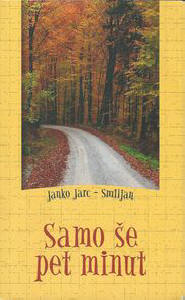
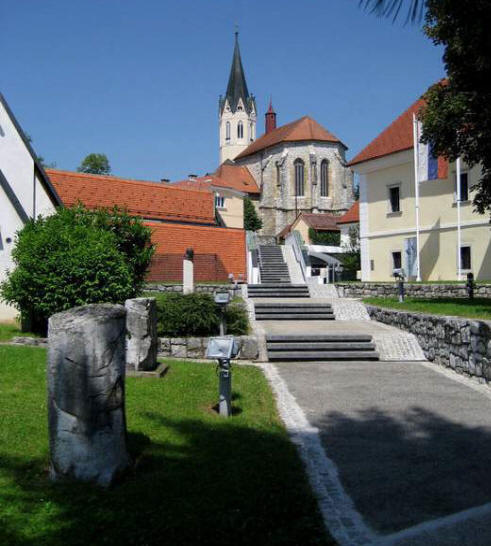
There really wasn't a lot to see in here but I took these shots of Mranko Tisu's "Collapse of an Idea" which is made from old rockets from the recent war (below left) and Janko Grač's painting "On the Edge III" (1991.) I took a shot of the town from the museum window.
.jpg)
.jpg)
.jpg)
I left the Gallery and went back inside the main building and got to the area where they describe the Slovenes' role in the wars of the 1700s and the Napoleonic Era.
.jpg)
Then into the next large room where they tell the story of their independence from Communist Yugoslavia to become the Republic of Slovenia. It is quite an interesting story to read if you are interested.
.jpg)
.jpg)
.jpg)
.jpg)
.jpg)
.jpg)
.jpg)
.jpg)
.jpg)
.jpg)
Here are photos of the various monuments they have erected to memorialize the victory. And of course, their national flag of red, white and blue.
.jpg)
.jpg)
Below left is an official sign for the offices of the Socialist Republic of Slovenia. On the right is an election campaign poster for their first President Milan Kucan in April 1990.
.jpg)
.jpg)
They also had this beautiful aerial photo over Novo Mesto showing the deep bend in the Krka River. I looked out the window of the building and got this shot of the church up the street.
.jpg)
.jpg)
Here is the area describing WWII.
.jpg)
There were many military displays including the one of bomb shells (stock photos below.)
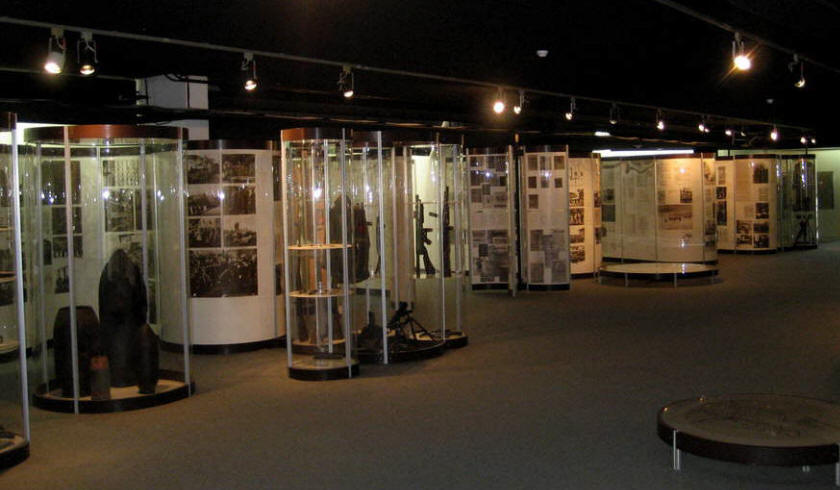
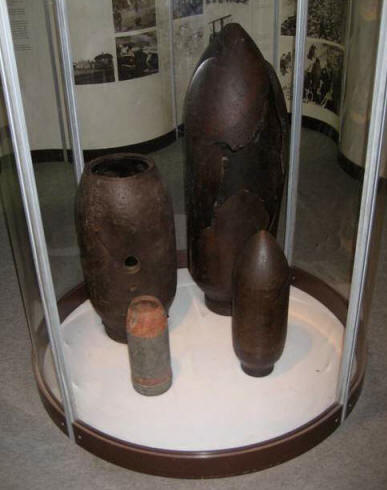
Next they had these military collections from the servicemen.
.jpg)
There were many displays of the Yugoslav partisans who were fighting the Nazis including their guns.
.jpg)
.jpg)
.jpg)
.jpg)
There was a large memorial to those who died fighting the Nazis. These are all Marcia's photos of it. As you can see the walls behind it and surrounding it are covered with metal plaques listing the names of the dead.
.jpg)
.jpg)
Here are her close-up photos of the names.
.jpg)
.jpg)
As you can see the metal signs went all the way to the outside; there were lot of them.
.jpg)
.jpg)
The rest below are my photos. Here is of the map on the memorial (above) showing the military control of Slovenia by the Nazis (swastika, middle,) by Mussolini's troops (fascia, below) and Yugoslavia (crown, top.)
.jpg)
I then entered this large room dedicated to their world famous gymnast, Leon �tukelj.
.jpg)
Leon �tukelj [Shtook-elli] was born in Novo Mesto in November 1898 and as a child started a career in gymnastics. Between the Olympics and the World Championships, he won a total of 20 medals; 8 gold, 6 silver and 6 bronze. In the Olympics alone he won 2 gold in Paris in 1924, 1 gold and 2 bronze in Amsterdam in 1928 and a silver in Berlin in 1936 when he ended his career. He is the most successful Slovene gymnast sportsman up to this time and a giant in world gymnastics. Obviously they are proud of their native son.
.jpg)
.jpg)
.jpg)
Here is the display of his Paris medals and ...
.jpg)
.jpg)
... those from Amsterdam and Berlin.
.jpg)
.jpg)
They had these photos of him as an old man at the Barcelona Olympics (below left) and in 1997 at the Los Angeles Olympics at the LA Coliseum (below right) at the age of 99.
.jpg)
.jpg)
We left the museum at 4:10 and walked up the hill a block to visit that church up the hill called St. Nicholas Cathedral. We had to walk to the far other end of the church to find the entrance. It was empty except for this one man praying.
He came over to me and asked me what I was doing. I told him I was just taking pictures of the beautiful church.
Here is the main altar (above right, below left,) a medieval burial plaque (center) and a holy water font (right.)
I then went down the stairway to the crypt area and entered this little altar area. You can see all the burial stones on the walls.
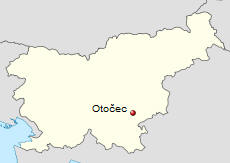
We walked back to the hotel and at 4:35
I drove us the two Km to the town of Kost
and at 4:45 I felt
hungry and bought 3
.jpg) packaged ham and mozzarella sandwiches which I combined into one.
At 4:50 we decided to visit
Otočec
(literally, "small island".) It was called �ent Peter until 1952
when the Communists eliminated Catholic names.
Otočec
Castle was first mentioned in written documents in the 13th Century.
packaged ham and mozzarella sandwiches which I combined into one.
At 4:50 we decided to visit
Otočec
(literally, "small island".) It was called �ent Peter until 1952
when the Communists eliminated Catholic names.
Otočec
Castle was first mentioned in written documents in the 13th Century.
.jpg)
It was built
on a small
island in the middle of the Krka River east of the main settlement. It is the
only water castle in Slovenia. The islet is linked to both banks
of the river by bridges and the castle has now been converted into a small
hotel.
The
![]() Otoĉec Castle
Hotel, [Grajska cesta 2, Otocec ob Krki,
Otoĉec Castle
Hotel, [Grajska cesta 2, Otocec ob Krki,
![]() +386-7-384-8900, www.terme-krka.si] is a
very plush place. We parked the car and then crossed the wooden bridge to
get to the castle.
+386-7-384-8900, www.terme-krka.si] is a
very plush place. We parked the car and then crossed the wooden bridge to
get to the castle.
The area is very nice. This would be a great place for a secluded little vacation.
In the middle of the bridge, the scene down the river was just beautiful and the water was like glass.
Here is the extent of the castle.
As we approached the hotel, I was wondering how the cars got here since we crossed a walking bridge. They must have come from the other side. I'm not sure what the bronze statue of the boy represented.
We were just in time to see this wedding party heading to the building.
I would imagine a lot of people get married here. I got this photo they had of an aerial of the castle.
.jpg)
They also has these others; an ancient sketch (left) and an old one (right) with the bridge in bad shape.
.jpg)
.jpg)
Since Slovenia is known as the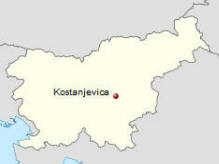
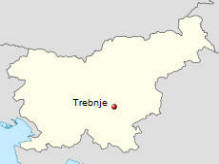 "Greenest Country in Europe," I tried to document
some of that on this long drive across the country. We took many back
roads and stayed off freeways and main highways just to see some of it. So I usually don't show
so many "out of the window" shots but here I will to give a feel of this
country.
"Greenest Country in Europe," I tried to document
some of that on this long drive across the country. We took many back
roads and stayed off freeways and main highways just to see some of it. So I usually don't show
so many "out of the window" shots but here I will to give a feel of this
country.
We got back into the car and at 5:05 I was attempting to drive the 25.5 miles (41 Km) to Kostanjevica (left.) It has a population of only 39. But, the GPS took me on this new A-2 highway to Trebnje (Official Site) which has a population of 3,478. We arrived there at 5:25. I got of shot of their local church.
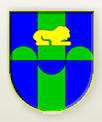
.jpg)
.jpg)
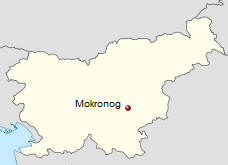
I then drove the 9.3 miles (15 Km) to the smaller town of Mokronog Trebelno (Official Site) with a population of 400 and at 5:55 drove another 8 miles (13 Km) more until 6:10 when Marcia took over and drove the remaining 43.5 miles (70 Km) to our destination, Roga�ka Slatina. Below left is a shot of the car's GPS screen. Below right we passed this very large wine casket with a cork in it. Quite unusual.
.jpg)
As you go through the rolling fields and farms, you come across these wooden structures which are called kozolecs (hayracks) (below right.)
Here we came across a very small town and its church (below left) and then a small chapel that looked like a castle alongside the road. All photos were taken on the fly out the window as we drove through.
The roads became smaller and very windy as they bypassed the borders of the various farms. Here (below right) is another classic example of a kozolec.
The kozolec
is a freestanding vertical drying rack found chiefly in Slovenia. They are
permanent structures, primarily made of wood, upon which fodder for animals is
dried, though their
use is not limited to drying hay. Other food stuffs
such as field
maize
(corn) are dried on them as well. Although it
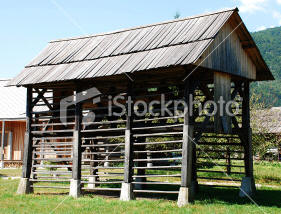 is a practical
structure, they are often artistically designed and handcrafted and are
thought of by Slovenes as a form of vernacular architecture that
marks Slovene identity. They can be found in about 80% of Slovenia
except in the Prekmurje region, eastern Styria and the Slovenian Littoral. Similar structures can also be
found in Friuli in Italy and in the East Tyrol region of Austria. In German, it
is called Harpfe or K�se. Other Slovene names for it are kazuc,
stog, and toplar. The former is very colloquial and is usually attached to the
single, stretched form known as the enojni kozolec. The stog is commonly found
in the Upper Carniola and especially in the area around Studor in the Bohinj
region. Toplar is the common name for the double-hayrack or dvojni kozolec found in the Lower Carniola
and
differ architecturally. Here are some stock photos of them.
is a practical
structure, they are often artistically designed and handcrafted and are
thought of by Slovenes as a form of vernacular architecture that
marks Slovene identity. They can be found in about 80% of Slovenia
except in the Prekmurje region, eastern Styria and the Slovenian Littoral. Similar structures can also be
found in Friuli in Italy and in the East Tyrol region of Austria. In German, it
is called Harpfe or K�se. Other Slovene names for it are kazuc,
stog, and toplar. The former is very colloquial and is usually attached to the
single, stretched form known as the enojni kozolec. The stog is commonly found
in the Upper Carniola and especially in the area around Studor in the Bohinj
region. Toplar is the common name for the double-hayrack or dvojni kozolec found in the Lower Carniola
and
differ architecturally. Here are some stock photos of them.
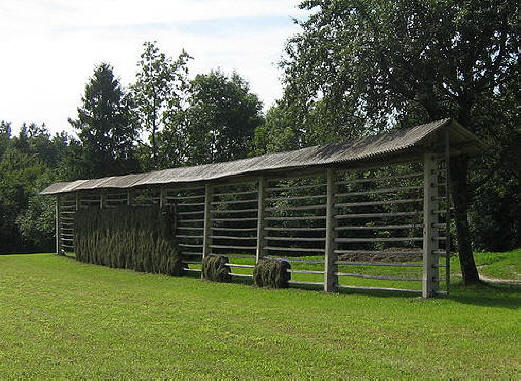
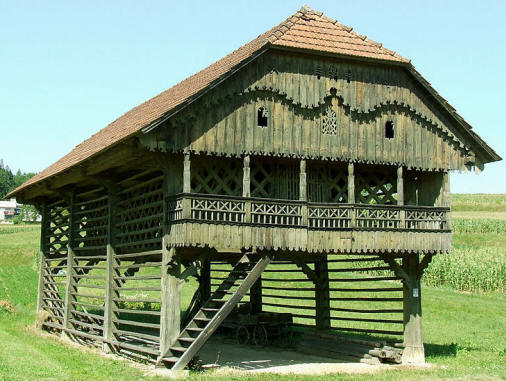
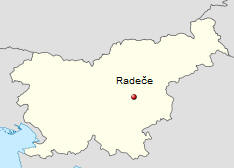
Then we approached Radeče, a small town in the Lower Sava Valley in eastern Slovenia. It's in the Sava Hills (Slovene: Posavsko hribovje) on the right bank of the Sava River at its confluence with Sopota Creek. It is part of the traditional province of Lower Carniola.
.jpg)
It is a cute little town on the river with a population of 2,186. Stock photo below.
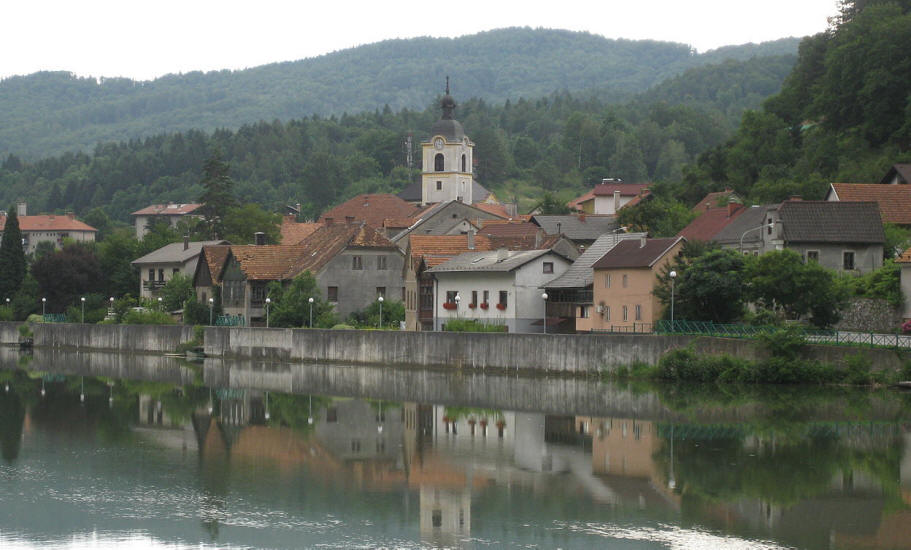
Now we continue through the countryside fields.
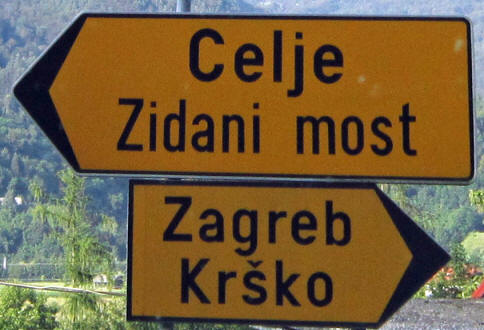
Here we crossed the Sava River.
.jpg)
We crossed via the Zidani Most (Bridge.)
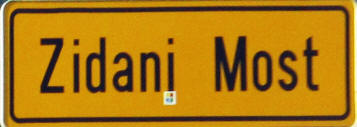
.jpg)
We are heading to the city of Celje and crossed the Savinja River.
.jpg)
Plenty of mountains and trees passed us by.
We went past many little towns. Another larger kozolec (below left.)
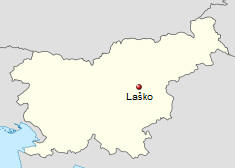
 At 6:30 we
passed through the city of La�ko
(Official Site) and
and went by the their famous La�ko beer brewery.
It's elevation is 853 ft (259.9 m) and has a population
of 3,416. It is described as a gorgeous town that holds a weeklong celebration in honor of its main
product, beer. Below is our GPS going through town and a shot of the back
of the main brewery. Did I mention before that the beer is pretty good?
At 6:30 we
passed through the city of La�ko
(Official Site) and
and went by the their famous La�ko beer brewery.
It's elevation is 853 ft (259.9 m) and has a population
of 3,416. It is described as a gorgeous town that holds a weeklong celebration in honor of its main
product, beer. Below is our GPS going through town and a shot of the back
of the main brewery. Did I mention before that the beer is pretty good?
.jpg)
We then passed by the front of the brewery which they call Pivovarna La�ko with their goat emblem. They have been brewing beer here for 186 years.
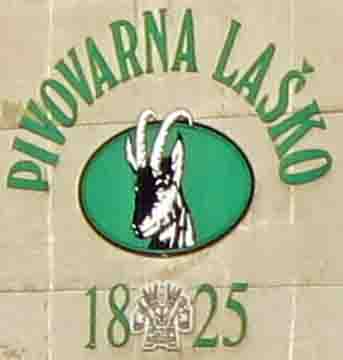
The guidebooks tell you not to miss their lively festival held in July if you want to witness Slovenia's penchant for polka bands, street parades, and all-night merrymaking. Well, guess what? We are driving through right during their festivities - and we're going to miss it.
The whole town was out with many booths and exhibits and people all over the place.
The smoke you see is from stands cooking fresh food. It isn't the Budweiser team but the beer truck was neat.
This festival draws people from all over. Some have mobile home buses (above right) while most are sleeping in tents in the nearby fields (below.)
We went by this large shopping center as we left the city (below right, red cross lines means you've left.)
.jpg)
Another kozolec and some cornfields.
.jpg)
Fifteen minutes later we were driving through the large city of Celje but did not have time to visit it.
Toward the center of town this traffic circle was an elaborate fountain.
As we are leaving the city and now have to take a right turn toward Croatia [HR.]

Many of their traffic circles have interesting displays.
This bridge from building to building is probably quite helpful in the winter.
At 7:00 we stopped so I could test my blood sugar after eating those sandwiches. I then went over a photographed these goats.
.jpg)
Here we are leaving the small town of Sentjur and I got shots of this church from several angles.
Here is another haystack behind the grape vines as we are entering Grobelno.
There was this sign about �marje pri Jel�ah in Kalvarija which is a pilgrimage site.
.jpg)
.jpg)
Here are stock photos of the 14 stations of the cross to the top of the hill (left,) the main church St. Rok at the top (center,) and one of the many station chapels (right.) You climb the big hill stopping at the chapels. It was built after the �marje plague.
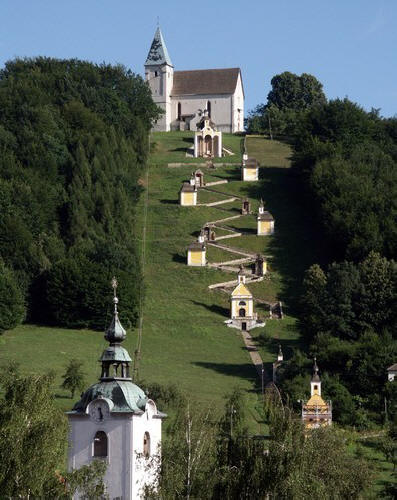
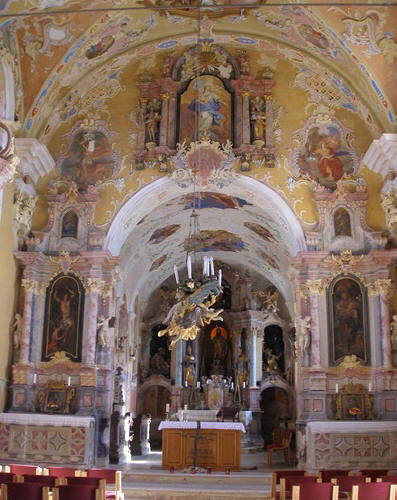
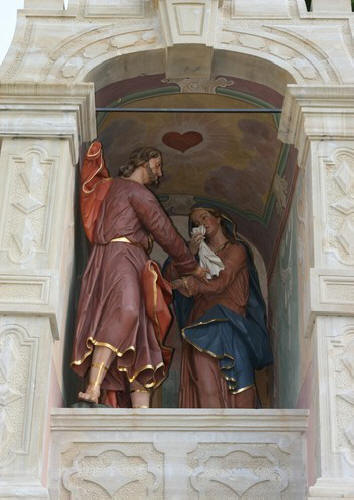
We had no time to visit it. There are many curves in this two-lane road.
This signs tells us we are nearing the town of
Sladka Gora and their
Marijina cerkev. The Church of Mary [Sladka Gora 11, Sladka Gora, �marje
pri Jel�ah,
![]() +386-358-421]
was built in 1754 and sits over the Paloma Vineyards. It is one of the
most beautiful Baroque pilgrimage churches in the country. It is built in
the typical baroque style with playful towers and a fractured roof. It has
frescoes by Franz Jelov�ka and a magnificent miraculous statue of Our Lady on
the main altar.
+386-358-421]
was built in 1754 and sits over the Paloma Vineyards. It is one of the
most beautiful Baroque pilgrimage churches in the country. It is built in
the typical baroque style with playful towers and a fractured roof. It has
frescoes by Franz Jelov�ka and a magnificent miraculous statue of Our Lady on
the main altar.
.jpg)
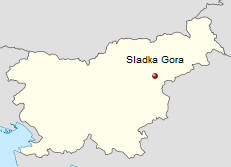
Here are stock photos of it.

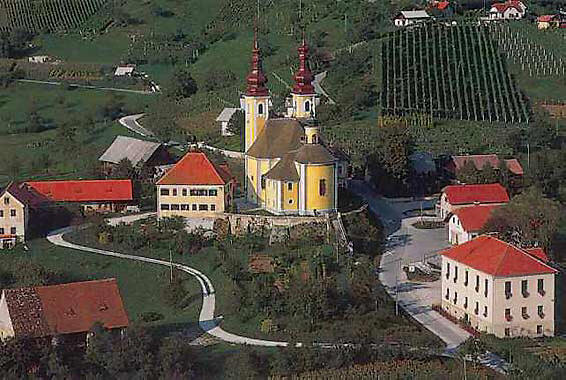
We bypassed Sladka Gora, Lemberg, Bre�ice and Podčetrtek. Here is a quite huge kozolec.
.jpg)
This whole trip from Novo Mesto should have been 85 miles (Km) and taken us 2
hours 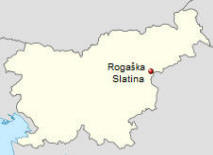 and 45
minutes.
and 45
minutes.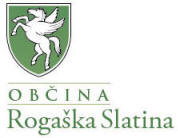
At 7:30 we finally pulled into the outskirts of Roga�ka Slatina [Row-gosh-kah Slah-teen-ah] (Official Site) but wind up going in circles trying to find our hotel. We finally got there after a half hour of driving around. It is surprising since this little town is only 2.1 mi2 (5.4 Km2) in size. It has a population of 5,105 and sits at an elevation of 734 ft (224 m.) Below are some stock photos of the town.





![]() At 8:00
we checked into
Hotel
Zagreb [Zdraviliski trg 6,
At 8:00
we checked into
Hotel
Zagreb [Zdraviliski trg 6,
![]() +386-3- 811-4000,
darnijan@hotel-sava-rogaska.si] which
I found on Booking.com. Below is the front of the Hotel Zagreb.
+386-3- 811-4000,
darnijan@hotel-sava-rogaska.si] which
I found on Booking.com. Below is the front of the Hotel Zagreb.
I go in and wonder around in this old dark building and soon find someone who tells me I have to go through this hallway to find the reception desk. Below is where I wound up in this extremely modern fancy reception area that looked nothing like where I had been.
.jpg)
Marcia waited on the plush couch near this rather unusual painting (right) while I inquired as to what was going on. The painter (slikar) was Rudolf �panzel.
.jpg)
.jpg)
The lady at the desk, Liki (below right,) told me I was now at Hotel Sala and I can check in there for my Hotel ZAGREB hotel room and that they had my reservation. Since they are the same hotel, I asked why we couldn't have a room in this fancy part and she told me that if I wanted she would check how much it would be to change rooms.
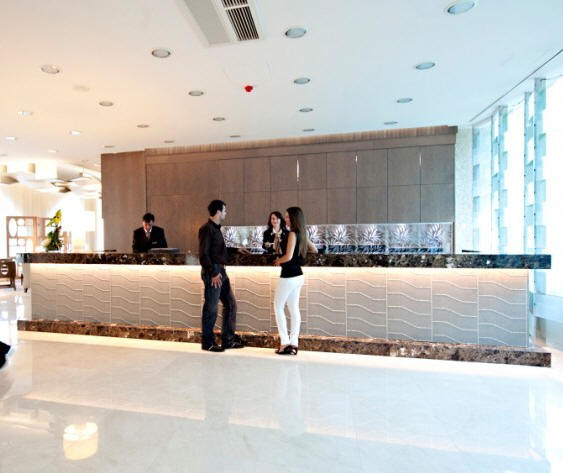
In the meantime, she gave me our room key. Well now we have two nights in a row with a misleading hotel in Slovenia thanks to Booking.com. [Don't forget, all the previous ones were fabulous.]
The real hotel is Hotel Sala, which is a large modern fancy hotel they show on the website. The Hotel Zagreb is an old broken down ancient place which is directly attached to it. This was a total "bait and switch" operation by the Hotel Sala, but Booking.com let them do it. Be very careful if you ever come here. They pretend it is a separate hotel until you get here. We wended our way back to the Zagreb and the dark hallways, which were barely lit, and got to our room.
.jpg)
.jpg)
It wasn't bad, but certainly not the modern room you would get at the Sala. After getting to our room and seeing it, I complained bitterly about this treatment and called Liki and she was trying to get us a room in the Sala. At 8:10 Liki calls me and offers me a room in the Sala for an additional �76. That would increase it from �90 to �166, a 73% increase. I told her no thanks. At 8:15 I found our bellman, Rok, and gave him a �3 tip and he came back later and gave us a free bottle of white wine; a real surprise.
[In 2013, the same room goes for �120 and the Sala is �240 with �1 = $1.30 instead of $1.41 as in 2011.]
The air conditioner was a standing unit (below left) and we chose to open the window.
Here is the grand front entrance of the Hotel Sala. The good thing is we have access to all the things at the Sala since there is nothing at the Zagreb. After unpacking, I took a walk around the Sala which was quite nice. Here is an eating area (below right.)
Here is more of the restaurant areas which are quite large.
They have a snack area and coffee shop as well as a place with live music.
I decided to wander out in the back and found a bar seating area where you could order a drink.
It was very nice, so at 8:30, I ordered a cold bottle of Union beer and just sat and relaxed after this very long day. I had a second beer and Marcia joined me for a glass of wine.
Here is the entire extent of the back of the Hotel Sala I did with PhotoStitch.
.jpg)
Here is a stock photo of it at night.
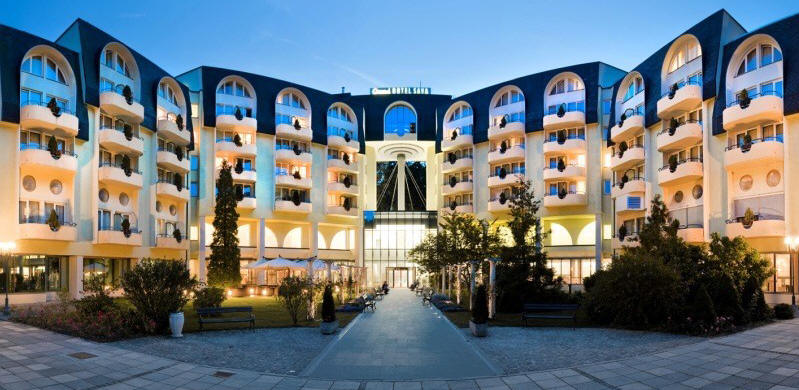
At 8:45 we decided to go
to dinner and we went to the Kaiser [![]() +386-3-811-4000]
which was rated as the best place to eat in town. It was located directly
under our room in the hotel building. We could hear all the noise coming
from it. So we headed there. These are my night photos.
+386-3-811-4000]
which was rated as the best place to eat in town. It was located directly
under our room in the hotel building. We could hear all the noise coming
from it. So we headed there. These are my night photos.
.jpg)
.jpg)
Here are some stock photos of it. Our room is just above on third (4th in EU) floor.
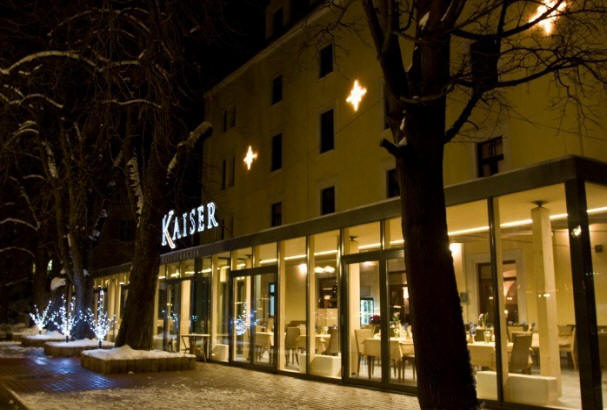
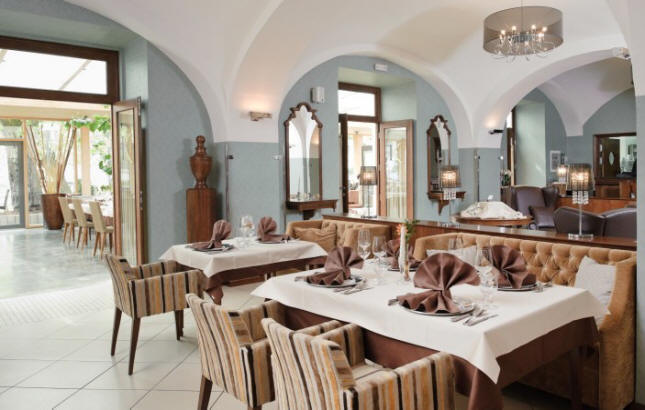
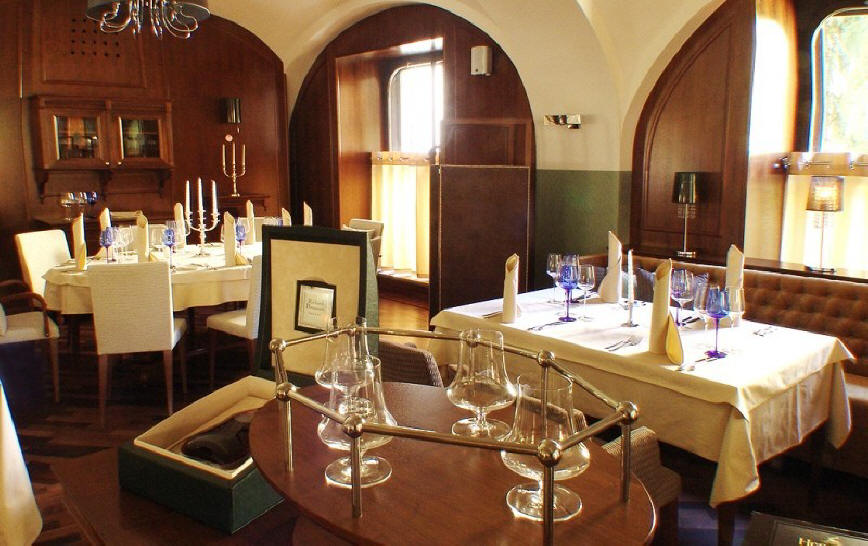
When we got there we found this sign on the glass door (below) in Slovenian, German (left,) Italian and Russian (right.) Between the Italian and German I deciphered that unfortunately the restaurant was totally closed for a wedding party. Between the hotel and this, it is not our day.
2.jpg)
.jpg)
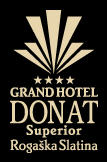
We then crossed the street to the Hotel Donat [Zdravili�ki
trg 10, ![]() +386-3-811-3000]
(stock photo below)
which is a very
glamorous place with a casino in it.
+386-3-811-3000]
(stock photo below)
which is a very
glamorous place with a casino in it.
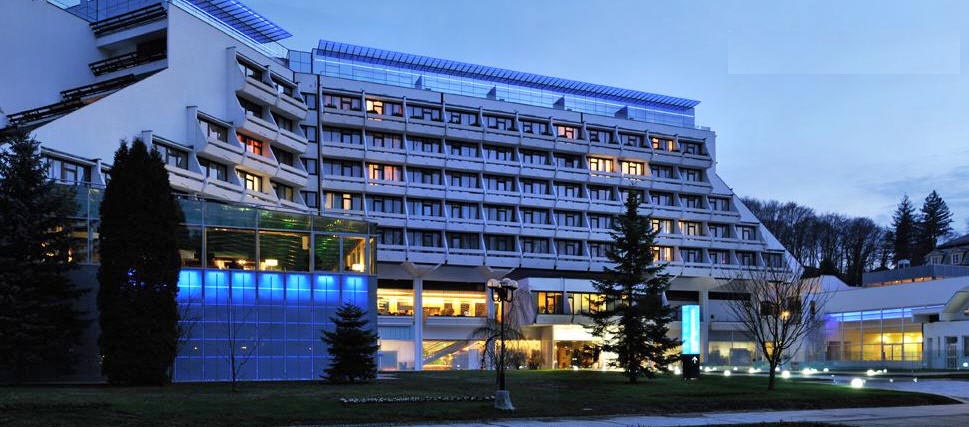
We went by the casino and found their restaurant but it was completely empty with just two musicians playing alone.
.jpg)
.jpg)
So we left there and walked down to this very impressive building which was all lit up for some special event.
.jpg)
People were arriving in their tuxes and gowns to a white glove reception. It was obvious we were not going to get dinner here so at 9:50 we went back to the Sava Hotel restaurant called the Restauraija Kristal but discovered it was now also closed 10 minutes earlier than the sign states (left.) I banged on the glass but someone signaled me to forget it and get lost. It just keeps getting better.
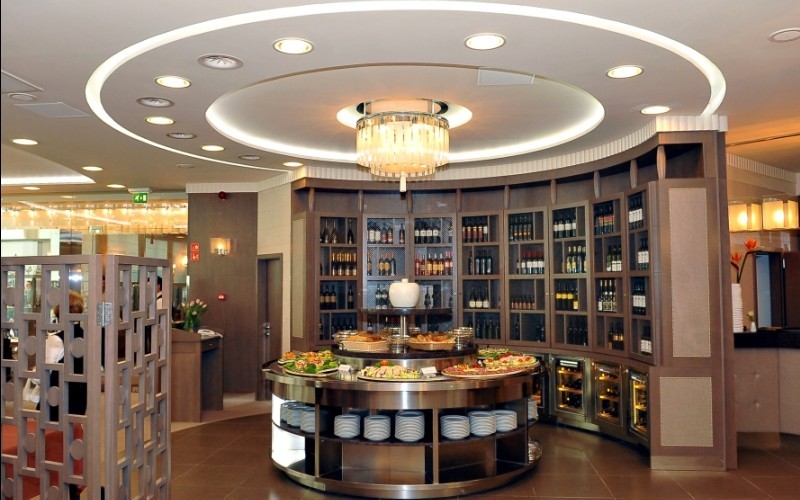
Here are some stock photos of what we missed (above right & below.)
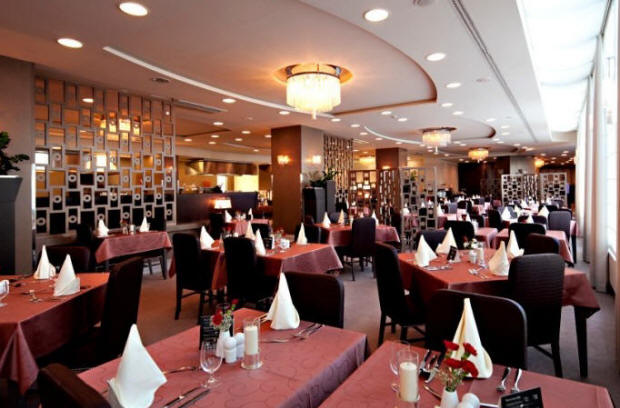
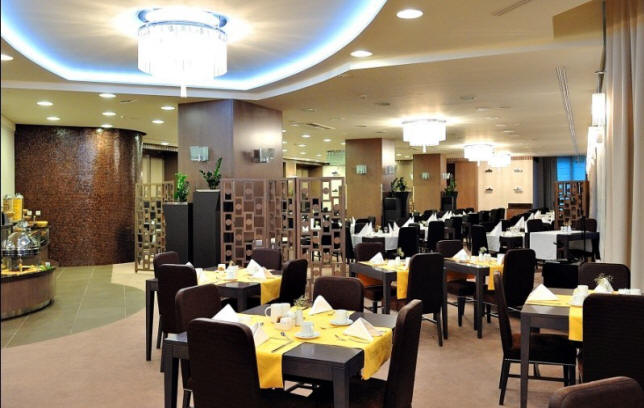
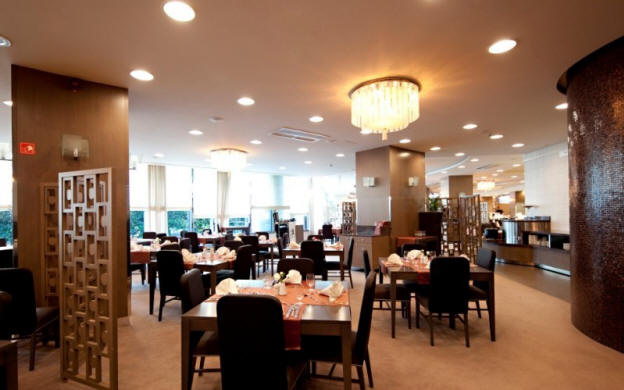
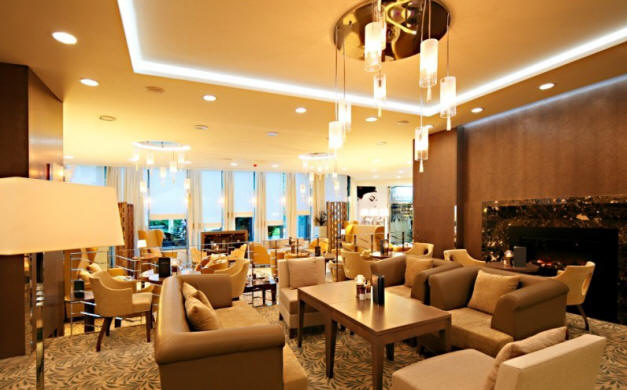
Below left is their display of "Kristal."
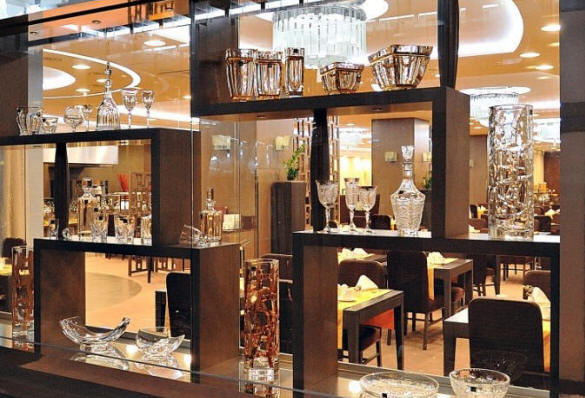
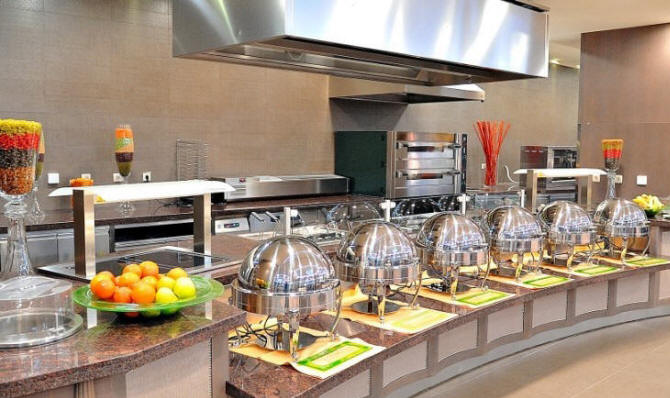
So now we are really stuck with no place to get anything to eat. I called Liki at the front desk again and told her of our hard luck and at 10:15 she had the restaurant kitchen send us up something to eat. So we sat in our room and drank our free wine and ate our free "dinner" brought up by Rok. We opened the W Cuv�e white wine.
The food they brought us consisted of chicken thighs, some kind of white fish with boiled potatoes, carrots, zucchini and bread.
The dessert was a cake, yogurt and some some fresh bananas and pears (below.) We had to appreciate what they did for us or we would not have had anything to eat at all. I guess you could say we saved about �100.
Marcia enjoyed it but unfortunately I thought it was really bad. We suddenly heard loud noises outside the window and I looked out and got to see the fireworks they were shooting off.
.jpg)
.jpg)
.jpg)
I never found out the reason for the celebrations. We got to bed at 12 PM which was a little early for us.
Kenneth J. Hoffer, MD
Roga�ka Slatina, Slovenia
Sent 5-1-2013
If you enjoyed these travels or wish to add comments on the places we visited
Please Leave Me a Message by clicking the spinning @ sign below.

